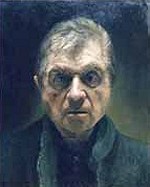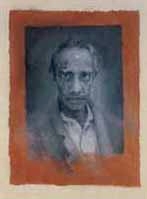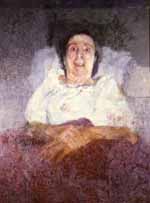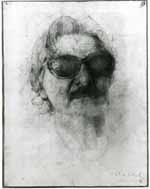|
|
The Collection of The Late Miss Valerie Beston
Artists from The London School - 8 and 10 February © 2006 - Christie's

Michael Clark first walked into Colony Room off the street in 1977 (and promptly found himself back on it). This initial encounter with the notorious club, with its owner Muriel Belcher and of course with Bacon, introduced Clark to a world in which he would thrive, and which he would poignantly capture in his penetrating pictures over the coming years. Despite being thrown out, Clark became a friend of Belcher – who affectionately credited him as a ‘cheeky ****’ for his brazen first attempt at entry there - and of her business partner Ian Board, as well as Bacon. Indeed, it was through the encouragement of Bacon, Belcher and Board that Clark took up painting again, having earlier abandoned it. It was also through Bacon and Belcher that he was introduced to Valerie Beston, with whom Clark had the almost unheard-of honour of being on first-name terms. Very early on, she told him, ‘You have the gift, and I am going to support you,’ and began buying his pictures, including the first one he ever sold. This was her direct means of supporting artists, one that had helped other prestigious people such as Auerbach in its time. She also welcomed Clark often in the Malborough Gallery, showing him Bacon’s works, giving him tea as well as personal advice. Once she even called him into the gallery and presented him with a great surprise - the chance to view and to hold one of his favourite Cézanne paintings, an opportunity she had extended only to the ‘real painters’ – himself, Bacon, Auerbach, Freud.
 It was Miss Beston, in turn, who suggested that Clark make a portrait of Bacon, a proposition that both artists found fantastic. She told Clark to call Bacon, and they arranged for a first sitting that sparked off a series of pictures from which Bacon’s gaunt and time-worn face stares. At the first sitting Clark arrived, as requested, early in the morning and was ushered by the artist into the house. Bacon, ever the consummate host, immediately offered Clark something to drink, but the catalogue of spirits, rather than hot drinks, that was reeled off stumped the younger, bleary-eyed artist, who compromised - as he thought - by asking for a beer. His considerate host then disappeared not to the kitchen but to an off-license, beer clearly not one of his stable supplies. Over the subsequent years, working from numerous sittings and photographs, Clark’s meticulous draughtsmanship captures the appearance but also the soul of the older tormented artist. It is a credit to his uncanny ability to record Bacon that several of these drawings were collected by the dedicated and discerning Miss Beston, as well as the British Museum.
 Clark is a self-confessed Bacon fanatic, one who had the added benefit of being his friend and portraitist. Bacon’s influence threads through his works, reappearing even in his conceptual pieces. Be it in the appearance of wounds in his paintings, or in the location of a ‘sound sculpture’ outside a sex shop that Bacon used to frequent (only in part to cash his cheques), his ghostly spectre appears again and again, if only obliquely, in his figurative and conceptual works. For Clark is not a portraitist, although he has created many portraits of people ranging from film directors to the characters of Soho of yesteryear to Royalty to Pop royalty. He is a conceptual artist, for whom the painstakingly accurate depiction of the human face is only one of his means or media, and conversation with him ranges from the diverse influences of Rimbaud and Nauman as well as Holbein and Rembrandt.
 Death seems to have followed Clark, informing some of his greatest and most poignant works. Be it is his grisaille portrait of Derek Jarman, in the dispersed wounds of Christ in Chichester Cathedral, or in the haunting images of Belcher, death appears to have already cast its shadow. Even the pictures of Bacon, executed before any illness, show vulnerable eyes contained within the hanging skin, The texture of these pictures is of a hallucinatory richness, the face is the sole and compelling focus of Clark’s piercing gaze, and yet the skin appears all the more vulnerable. It is brittle and crumpled, hinting at its fragility as a package for a human life. Nowhere is this more true than in the images of the gaunt, drained Muriel Belcher, whom Clark helped during her lingering final illness. Clark says that these pictures were executed when he was young, when death was an alien concept and seemed ‘a long way away’ – something that happened to other, older people. And yet he has constantly shown a fascination with it, his pictures existential examinations of the body, of life, of its fragility-in short, of the human condition that drove Bacon’s own works. It is therefore not surprising to hear Clark quote Bacon, in turn quoting Cocteau: ‘We look at death at work every day in the mirror.’ |
The Collection of The Late Miss Valerie Beston
Artists from The London School - 8 and 10 February © 2006 - Christie's
Wikipedia
Video
In our 'Francis Bacon: First Impressions' series of interviews, each interviewee was asked ‘What were your first impressions upon meeting Francis?’
In this film the artist Michael Clark talks about meeting Bacon and Muriel Belcher at the Colony Room Club, as well as visiting Bacon's studio and Bacon sitting for him.
First Impressions is directed by Harriet Vyner, and produced by the Estate of Francis Bacon in partnership with HENI Talks. |